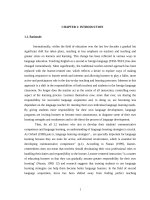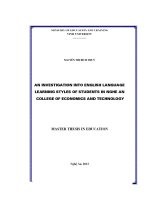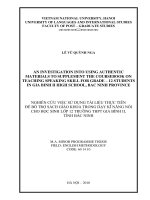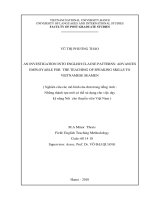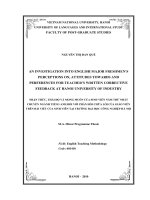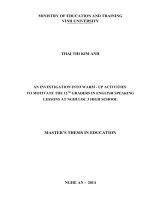An investigation into english idioms relating to fruit with reference to the vietnamese equivalents
Bạn đang xem bản rút gọn của tài liệu. Xem và tải ngay bản đầy đủ của tài liệu tại đây (1.17 MB, 78 trang )
DANG THI THANH HUONG
MINISTRY OF EDUCATION AND TRAINING
HANOI OPEN UNVERSITY
AN INVESTIGATION INTO ENGLISH IDIOMS
RELATING TO FRUIT WITH REFERENCE TO THE
ENGLISH LINGUIAGE
VIETNAMESE EQUIVALENTS
( NGHIÊN CỨU CÁC THÀNH NGỮ TIẾNG ANH VỀ TRÁI CÂY
TRONG SỰ LIÊN HỆ TƯƠNG ĐƯƠNG VỚI TIẾNG VIỆT )
DANG THI THANH HUONG
2013 - 2015
Hanoi, 2016
MINISTRY OF EDUCATION AND TRAINING
HANOI OPEN UNVERSITY
M.A. THESIS
AN INVESTIGATION INTO ENGLISH IDIOMS
RELATING TO FRUIT WITH REFERENCE TO THE
VIETNAMESE EQUIVALENTS
(NGHIÊN CỨU CÁC THÀNH NGỮ TIẾNG ANH VỀ TRÁI CÂY
TRONG SỰ LIÊN HỆ TƯƠNG ĐƯƠNG VỚI TIẾNG VIỆT )
DANG THI THANH HUONG
Field: English Language
Code: 60220201
Supervisor: Dr.Nguyen Thi Van Dong
Hanoi, 2016
CERTIFICATE OF ORIGINALITY
I, the undersigned, hereby certify my authority of the study project report
entitled a study on English idioms relating to fruit with reference to the
Vietnamese equivalents submitted in partial fulfillment of the requirements
for the degree of Master in English Language. Except where the reference is
indicated, no other person’s work has been used without due
acknowledgement in the text of the thesis.
Hanoi, 2016
Dang Thi Thanh Huong
Approved by
SUPERVISOR
(Signature and full name)
Date:……………………
i
ACKNOWLEDGEMENTS
I would like to express my deepest gratitude to all those who gave me the
possibility to complete this thesis.
First of all, I am deeply indebted to my beloved supervisor, Dr. Nguyen
Thi Van Dong for the invaluable support, enthusiastic guidance, and
encouragement he gave me throughout my research. I am truly grateful to her
for his advice and suggestions right from the beginning when this study was
only in its formative stage. Without her untiring patience in reading the
manuscript and clarifying my ideas, the thesis would have never been in the
current shape.
Secondly, I would like to give our thanks to all lectures of Postgraduate
Faculty at Hanoi Open University for their valuable teaching and tremendous
assistance that have enlightened my study path.
Thirdly, I am also indebted to the field workers who were kind enough to
tolerate the painstaking task of collecting the data. Then my thanks also sent
to my classmates at the Master Course Class who have taken time and trouble
to alert me to errors in my thesis and provided me with useful data on which
this thesis is based.
Finally, I would like to express my gratitude to family members whose
support and encouragements have greatly contributed to the completion of my
study. For my little experience and knowledge, I would like to receive more
useful comments from lectures and others.
ii
ABSTRACT
Idioms are used regularly and naturally in everyday communication, however,
the inner meaning of the concept of idioms is still unclear to a lot of people.
Therefore, the author thinks a study on the subject of idioms in Vietnamese and
English is helpful for improving the knowledge of language learners, as well as
the students learning English in general. In the study the author finds out that a
semantic and syntactic analysis of English and Vietnamese idioms relating
to fruit has shown that English and Vietnamese
idioms relating to fruit
mention appearance, moods and feelings, love affairs and relationship, success
or failure. Besides that the use of English and Vietnamese idioms can be
explained
behavior,
attitude,
activity
and
action,
advantageous
or
disadvantageous situation, poverty, geography. Although idioms are classified
in different groups in which the author chooses semantic and syntactic of
English idioms relating to fruit with reference to the Vietnamese
equivalents to be my subjects as they occupy a significant role and have
special structure, is an appropriate subject for a study contrastive. Besides that,
the survey in the form of questionnaire carried out by 60 students in the First
year students at University of Economics and Technical Industries is to find out
the command mistakes in using Fruit idioms in English. Finally, some
implications for teaching and learning of English at University of Economics
and Technical Industries were suggested.
iii
LIST OF TABLES AND FIGURES
Table 4.1: Brief description of the semantic features of English and
Vietnamese idioms relating to fruit
Table 4.2.1: Syntactic features of idioms relating to fruit express
appearance in English and Vietnamese
Table 4.2.2: Syntactic features of idioms relating to fruit express moods and
feelings in English and Vietnamese
Table 4.2.3: Syntactic features of idioms relating to fruit express love affairs/
relationship in English and Vietnamese
Table
4.2.4:Syntactic
features
of
idioms
relating to fruit express
success/failure in English and Vietnamese
Table
4.2.5: Syntactic features of idioms relating to fruit express behavior/
attitude/ activity/ action in English and Vietnamese
Table 4.2.6:Syntactic features of idioms relating to fruit express advantageous/
disadvantageous situation in English and Vietnamese
Table 4.2.7: Syntactic features of idioms relating to fruit express poverty in
English and Vietnamese
Table 4.2.8: Syntactic features of idioms relating to fruit express geography in
English and Vietnamese
Table 4.2.9: Statistical summary of syntactic features of idioms in English
and Vietnamese
iv
Table of Contents
CERTIFICATE OF ORIGINALITY .............................................................. i
ACKNOWLEDGEMENTS ................................................................................ ii
ABSTRACT....................................................................................................... iii
LIST OF TABLES AND FIGURES ................................................................. iv
Chapter 1: ............................................................................................................ 1
INTRODUCTION .............................................................................................. 1
1.1. Rationale for the research ............................................................................. 1
1.2. Aims of the research ..................................................................................... 2
1.3. Objectives of research .................................................................................. 2
1.4. Scope of the research.................................................................................... 2
1.5. Significance of the research ......................................................................... 3
1.6. Structural organization of the thesis ............................................................. 3
Chapter 2 ............................................................................................................. 5
LITERATURE REVIEW ................................................................................... 5
2.1. Review of previous studies ......................................................................... 5
2.2.
Review of theoretical background .......................................................... 7
2.2.1. Theoretical framework ............................................................................ 7
2.1.2. Theoretical background ........................................................................... 8
2.1.2.1.Idioms ..................................................................................................... 8
a. Concept of idioms............................................................................... 8
b. Distinctive features of English idioms .............................................. 10
2.1.2.2. Idioms and other languages units ........................................................ 18
a. Idioms and proverbs ......................................................................... 18
b. Idioms and collocations ................................................................... 20
v
c. Idioms and clichés .......................................................................... 21
d. Idioms Relating to Fruit ................................................................... 22
2.3.
Overview of phrase structures ................................................................ 22
2.3.1 Verb Phrases ........................................................................................... 22
2.3.2 Noun Phrases ......................................................................................... 23
2.3.3 Prepositional Phrases .............................................................................. 23
2.3.4 Adjective Phrases ................................................................................... 23
2.4
Summary................................................................................................. 23
Chapter 3: .......................................................................................................... 25
METHODOLOGY ........................................................................................... 25
3.1.
Research-governing orientations ............................................................ 25
3.1.1. Research questions.................................................................................. 25
3.1.2 Research setting ...................................................................................... 26
3.1.3 Research approaches .............................................................................. 26
3.1.4 Criteria for intended data collection and data analysis .......................... 27
3.2. Research methods ...................................................................................... 27
3.2.1 Major methods versus supporting methods ............................................. 27
3.2.2 Data collection techniques ....................................................................... 28
3.2.3. Data analysis techniques ......................................................................... 28
3.3. Summary .................................................................................................... 29
Chapter 4: .......................................................................................................... 31
FINDINGS AND DISCUSSION ..................................................................... 31
4.1
Semantic features of idioms relating to fruit in English and in
Vietnamese ............................................................................................. 31
4.1.1. Similarities .............................................................................................. 35
4.1.1. Differences.............................................................................................. 36
vi
4.2
Syntactic features of idioms relating to fruit in English and in
Vietnamese........................................................................................................ 41
4.2.1. Syntactic features of idioms relating to fruit express appearance in
English and Vietnamese.................................................................................... 41
4.2.2. Syntactic features of idioms relating to fruit express moods and
feelings .............................................................................................................. 41
4.2.3. Syntactic features of idioms relating to fruit express love affairs/
relationship........................................................................................................ 42
4.2.4. Syntactic features of idioms relating to fruit express success/ failure ..... 43
4.2.5. Syntactic features of idioms relating to fruit expressing behavior/
attitude/ activity/ action..................................................................................... 43
4.2.6. Syntactic features of idioms relating to fruit expressing advantageous/
disadvantageous situation……………………………………………………44
4.2.7. Syntactic features of idioms relating to fruit express poverty ................ 44
4.2.8. Syntactic features of idioms relating to fruit express geography ........... 45
4.2.9. A statistic summary of syntactic features of idioms relating to fruit in
English and Vietnamese. ........................................................................ 45
4.3.
Similarities and differences in syntactic features of idioms relating to
fruit ......................................................................................................... 46
4.3.1. Similarities ............................................................................................ 46
4.3.2. Differences ............................................................................................ 47
4.4.
Implications ........................................................................................... 48
4.4.1. General suggestions on teaching idioms ............................................... 48
4.4.1.1. Cultural differences ............................................................................. 50
4.4.1.2. Word order in idioms ........................................................................... 50
4.4.1.3. Idioms and sound patterns ................................................................... 51
vii
4.5 . Summary ................................................................................................... 51
Chapter 5: .......................................................................................................... 53
CONCLUSIONS .............................................................................................. 53
5.1 Recapitulation ............................................................................................. 53
5.2.
Concluding remarks................................................................................ 53
5.3. Limitations of the current research............................................................. 54
5.4. Recommendations and suggestions for a further research ......................... 55
5.4.1. Recommendations................................................................................... 55
5.4.2. Suggestions for a further research .......................................................... 56
BIOGRAPHY ................................................................................................... 60
APPENDIX ....................................................................................................... 61
viii
Chapter 1:
INTRODUCTION
1.1.
Rationale for the research
Language is a way to communicate ideas comprehensibly from one
person to another in such a way that the other will be able to act exactly
accordingly. And Idioms represent a subject-matter which is both interesting
and complex. Many linguists agree that research in this field is problematic
and tricky. Nevertheless, it can be said that idiomatic expressions are worthy
of studying as they constitute an essential part of our speech, of our everyday
communication. They bring both stability and playfulness to our language.
However, when teaching a foreign language, I found that this use of
language may cause some problems for foreign language learners since these
linguistic resources, as vocabulary in general, may belong to different levels
of language use in terms of formality or situational context. Idiomatic
expressions are characterized by unpredictable meanings or unusual
grammatical patterns, and they often convey specific connotations. Sometimes
non-native speakers lack confidence in using figurative language, especially
idioms, whose meaning often can not be predicted or understood from the
meaning of the words themselves. Consequently, people may misinterpret
what the other person is saying if they are not acquainted with the special
meaning of a particular expression.
The appointed reason is the condition of my theme choice. I would like
to choose An investigation into English idioms relating to fruit with
reference to the Vietnamese equivalents for my thesis topic with my desire to
1
help learners of Vietnamese improve their understanding of idioms, avoid
errors especially in translation and use them effectively as well.
1.2.
Aims of the research
The thesis is aimed at investigating the similatities and differences in
semantic and syntactic features of English idioms relating to fruit with
reference to the Vietnamese equivalents, thus suggesting some possible
implications for learning English.
1.3.
Objectives of research
To achieve the mentioned aims above, the following objectives can be
put forward:
- To find out similarities and differences c semantic features of English
idioms relating to fruit with reference to the Vietnamese equivalents.
- To find out similarities and differences in syntactic features of English
idioms relating to fruit with reference to the Vietnamese equivalents.
- To give some implications for teaching and learning English in general
and English in particular idioms relating to fruit.
1.4.
Scope of the research
Due to the time and research limitation, the thesis focuses on studying
the syntactic and semantic features of idioms relating to fruit, analyzing
collected from dictionary in both languages: English and Vietnamese. This
thesis mainly focuses on semantic features and syntactic features of English
idioms relating fruit and their Vietnamese equivalents. Other aspects are out of
the scope of this study. They, although can be found somewhere in this paper,
are only meant to support of illustrate some arguments of the author.
2
With a view to completing the research all the material collection of the
English idiomatic expressions relating to “FRUIT” and their Vietnamese
equivalents are hoped to be taken from the Internet and printed materials such
as: dictionaries – Oxford Dictionary of Idioms (2010), Từ Điển Thành Ngữ
Anh-Anh-Việt (2004), Thành Ngữ Tiếng Việt (2009), Từ Điển Thành Ngữ và
Tục Ngữ Việt Nam (2008), Từ Điển Thành Ngữ và Tục Ngữ Việt Nam (2006)
1.5.
Significance of the research
The research is expected to contribute an in-depth description of English
idiomatic expressions relating to FRUIT in terms of syntactic and semantic
features with reference to the Vietnamese equivalents, thus making a certain
contribution to improving the quality of English-Vietnamese translation done
by Vietnamese EFL learners at English Faculty of Hanoi Open University.
1.6.
Structural organization of the thesis
The study is organized into five chapters: Introduction, Literature
Review, Methodology, Findings and Discussion, and Conclusion.
Chapter 1 - Introduction: presents the rationale to the study, aims and
objectives of the research, scope of the research, significance of the study and
structure of the thesis.
Chapter 2 - Literature Review: provides the readers with the literature
review of the research, which attempts to present the theoretical background
including general understanding about language learning process, an overview
of English idioms relating to “FRUIT” and Vietnamese and their equivalents
3
Chapter 3 - Methodology: describes the research methodology in
details and comprises the information of the subjects, instruments of data
collection and methods of data analysis.
Chapter 4 - Findings and Discussion: presents syntactic and semantic
features of English idioms relating to FRUIT with reference to the Vietnamese
equivalents. The features are accompanied by statistical results and the analysis
of the data shown in the tables. The later part of chapter 4 works with some
implications for teaching and learning English idioms realting to fruit.
Chapter 5 - Conclusions: summarizes the thesis with concluding
remarks. Also, the limitations of the study are presented with suggestions for
further studies.
4
Chapter 2
LITERATURE REVIEW
2.1. Review of previous studies
Idioms have attracted many language researchers all over the world.
They are an important factor in native – like discourse by English as well as a
foreign language speaker. There are some important books such as “Idioms
Organization” by Wright, “The American Heritage Dictionary of Idioms” by
Ammer or “Oxford Dictionary of English Idioms and so on.
In Vietnamese, there are many authors has studied about idioms such as
“Thành Ngữ và Tục Ngữ Việt Nam Chọn Lọc” by Trần Quang Mân, “Từ Điển
Thành Ngữ Anh Việt” by Lã Thành ,“Từ Điển Thành Ngữ Tiếng Anh” by
Vĩnh Bá , Hoàng Văn Hành with “Thành ngữ học Tiếng Việt”.
Up to now, there have been some studies conducts to find out features and
related aspects of idioms such as : “ A study on English and VietNamese idioms
relating to spiritual life” by Phan Thi My Hanh ( 2011) at Da Nang University. In
the minor thesis , she presented, describled and analized the spiritual life – related
English and VietNamese idioms from a lingual cultural perspective.
A minor thesis is “A study of idioms relating family in English and
Vietnamese” by Tran Ngoc Que Chau( 2011).in her research paper, Tran Ngoc
Que Chau (2011) studies syntactic and semantic features of family idioms in
English and Vietnamese. She analyses 462 idioms relating family in English
and Vietnamese in terms of syntax and semantic, and indicate the distinction
between idioms meanings by native speakers of English and Vietnamese.
Syntactically, the classification of the data is mainly based on the different
structural categories, namely: noun phrases, verb phrases, adjective phrases,
5
prepositional phrases and adverbial phrases. With
regard to the semantic
results, the data reveal that the meanings of all the collected family idioms in
English and Vietnamese could be expressed through such means as metaphor,
metonymy and symmetry. Based on the functional grammar viewpoint, the
author has investigated each semantic field based on superficial grammatical
structures. In the light of this approach, idioms are analyzed in forms of phrasal
structures and clause structures in relation to their semantic features. The
phrasal structures could be categorized into noun phrases, verb phrases,
prepositional phrases and adverbial phrases. Besides, idioms are also structured
by clauses.
Besides, Tran Ngoc Que Chau (2011) compares and contrasts idioms
relating family in English and Vietnamese in terms of syntax and semantics. In
the syntactic aspects, idioms in English and Vietnamese are analyzed under
phrasal structures. These structures are categorized into noun phrases, verb
phrases, adjective phrases and prepositional phrases. Semantically, English and
Vietnamese idioms relating family in her study express their meaning through
such means as metaphor, metonymy, hyperbole and symmetry.
However, up to now, there have been no studies on idioms relating to
fruit. This is the reason why the author of this study finds that examining on
idioms relating fruit is interesting and worth-doing. She, however, does not
study the structural aspect of idioms but desires to look at idioms relating to
fruit in English and their Vietnamese equivalents in terms of their meaning and
its cultural aspect. She does hope that she can find out their similarities and
differences in semantic and cultural features, then on that basis propose some
6
implications for teaching and learning idioms relating to fruit in particular and
English idioms in general.
2.2. Review of theoretical background
2.2.1. Theoretical framework
There have been a number of writers making investigations into idioms
with different points of view and objectives. In English, there are some famous
ones being collected and written by researchers such as “The American
Heritage Dictionary of Idioms” by Ammer (2009). In “NTC’s American
Idioms Dictionary”, Spears, R. and Kirkpatrick, (2007) focus on the meaning,
usage and appropriate contexts for each idiomatic phrase. Nguyễn Lực, Lương
Văn Đang (2009) are two authors who made a significant contribution in the
field of Vietnamese idioms. They wrote “Thành ngữ Tiếng Việt” which is a
collection of Vietnamese idioms arranged in alphabetical order with clear
explanations and examples extracted from Vietnamese novels, newspapers and
magazines. Moreover, Nguyễn Trần Trụ who wrote “Thành ngữ tục ngữ lược
giải” (2008) explains meanings of the most common idioms and proverbs in
such simple, clear ways that learners can use this book for consulting and
reference purposes.
After that, it is the appearance of “Từ điển thành ngữ tục ngữ Việt
Nam” by Đặng Hồng Chương (2007), “1575 Thành ngữ - Tục ngữ cần bàn
thêm” by Lê Gia (2009) … and a number of contrastive studies on the various
aspects of idioms have been carried out by Vietnamese researchers.
Among the important approaches that look into the study of diverse
idioms definition, distinctive features of English idioms, distinction between
7
idioms, proverbs and some other terms: sayings, phrasal verbs, colloquialisms
and so on. These approaches give insights into understanding how certain
English idiomatic expressions relating to FRUIT with reference to the
Vietnamese equivalents could be put under an investigation.
2.1.2. Theoretical background
2.1.2.1. Idioms
a. Concept of idioms
Up to now, there are many definitions of idioms. From Simple English
Wikipedia , an idiom is defined as “a word or phrase which means something
different from what it says”. Broukai considers that idioms are “any
polylexonic lexeme made up of more than one minimal free form of word”.
Accordingly, idioms are units realized by at least two words. In addition, “the
meaning of an idiom is not predictable from its component parts, which are
empty of their usual senses”. Jackson, Amvela and Palmer (2000, p.66), share
the similar viewpoint on idiom definition, “an idiom may be defined as a
phrase the meaning of which cannot be predicted from the individual
meanings of the morphemes it comprises”. Palmer (1990), states that an idiom
is an expression whose meaning cannot be inferred from the meanings of its
parts. It can be seen that there are two visible points in their statements. First,
an idiom is a phrase; second, its meaning is not simply the meanings of
constituents making up the phrase. Having the same point of view is Seidle
and Mordie (1978, p.8) who consider “an idiom is a number of words which,
taken together, mean something different from the individual words of the
idiom when they stand alone” Collins has a different way to define idioms
but shares the similar idea. To take the definition by Collins (1995) to
8
consider, an idiom is a special kind of phrase. It is a group of words which
have a different meaning when used together from the one it would have if the
meaning of each word were taken individually […] idioms are typical
metaphorical: they are effectively metaphors which have become “fixed‟ or
“fossilized‟. In his definition, there are two noticeable terms, “typical
metaphorical” and “fossilized” used to describe idioms. “Metaphorical‟ could
be referred to figurative and non-literal characteristics of idioms. In the
meanwhile, “fossilized” implies unchangeable property of idioms. It can be
seen from the definitions mentioned above; the linguists have defined idioms
just in terms of their semantics and syntax.
Idioms, like proverbs, are common sayings. However, they usually do
not make sense at first sight and do not offer any advice: “to blow one’s own
trumpet”, which means, to praise oneself or boast…
So that, idioms are fixed expressions that are commonly used. They are
not complete sentences but words- An idiom is equal to a phrase.
Idioms do not give comments, experience, a moral lesson, advice that
made idiom aesthetic not educated, that is the reason why an idiom does not
become a literary work- idioms belong to the language.
In Vietnamese, idioms have also attracted a lot of the interest of
researchers. Mai Ngọc Chừ, Vũ Đức Nghiệu and Hoàng Trọng Phiến [53,
pp.153-165] state that “idioms are groups of words which are syntactically
restricted and have a particular meaning. Their meanings are often imaginative
and figurative”. According to Nguyễn Như Ý , an idiom “is a phrase or a
fixed syntactic group has a monolithic semantics” Nguyễn Lân defined that
9
idioms are fixed phrase to express a concept. Hồ Lê stated that “an idiom is a
word combination which has a stable structure and a figurative meaning, and
it is used to describe an image, a phenomenon, a characteristic or a state”.
Nguyễn Thiện Giáp was of the opinion that idioms are set expressions have
both the complete in meaning and valuable description. Idioms express
conceptions are usually based on specific images and symbols. An example of
a Vietnamese idiom “mặt xanh nanh vàng” or “mặt hoa da phấn” it only
indicates the aesthetic – beauty or fruit of a face not a comment or advice or
criticism. Even though an idiom can be ornate and flowery (aesthetic
function): so idioms do not bring about the full understanding about life and
any lesson of the people’s relationship in the society (function of education
and function of comprehension).
To sum up, an idiom is a phrase where the words together have a
meaning that is different from the dictionary definition of the individual
words, which can make idiom hard for English learners to understand.
b. Distinctive features of English idioms
Analysis of the idioms in terms of definition simultaneously
demonstrates some features of idioms. Idioms should be treated as a special
kind of every language. They separate themselves from regular rules
compared with other sorts of a language. In other words, only in idioms the
unacceptability in both meaning and form of a language could exist. If a
sentence “Many a little makes a mackle” immediately indicates the meaning
via its words, it could be changed into passive voice “a mackle is made by
many a little”. However, strangely enough, following the same form of every
form that could be changed into passive voice Agent – Action – Recipient,
the form mentioned above must not be employed in passive voice, otherwise,
10
it looks odd. Because, in fact “Many a little makes a mackle” is an idiom, it is
therefore necessary to be known as a fixed unit which does not permit any
rearrangement of its elements. Another aspect of idioms should be put into
consideration is semantics. Whether the sentence he loses his wallet should be
treated as having a meaning directly through words or an idiom relating
“losing a great deal of money”, it will depend on the context it is embedded
with. That means idioms deal with pragmatics.
b.1. Semantic features of English idioms
Lexical meaning of idioms follow different rules that unlike common
words. Idioms are composed of words however they are not the combination of
the meaning of each element forming them. All idioms have complete
meanings and they are generalized by all their forming elements. It is
undoubted that Figurative meaning is the basic characteristic of idioms which
helps to decide whether a fixed expression is an idiom or not. Here is an idiom
to exemplify: “to take one’s medicine” (to accept something unpleasant, for
instance, punishment, without protesting or complaining) in Vietnamese we
have “thuốc đắng dã tật, sự thật mất lòng”.
However, the meaning of these idioms can be guessed from the meaning
of their components. The meaning of an idiom is either partly or completely
different from the meaning of all components. In case of any partial difference,
their figurative meaning is not different from the literal one. The partly
different ones are such as kill two birds with one stone, to cut a long story
short, in seven heaven, etc.
Besides, idioms can convey positive, neutral, or negative meanings. For
the first group, conveying positive meaning we have some examples such as a
11
fair godmother (a person who helps you unexpectedly when you most need
help), the fruit(s) of something (the good result of an activity or a situation), be
(all) plain sailing (be simple and free from trouble). The second group,
examples of idioms expressing neutral meaning we have take a/the hint
(understand what somebody wants you to do, even though they tell you in an
indirect way), in somebody’s shoes (be in somebody’s position), bring
something home to somebody (make somebody realize how important, difficult
or serious something is). And in the last group typical examples of idioms with
negative meanings are monkey business (dishonest or silly behavior), a
mummy’s boy (a boy or man who is thought to be too weak because he is
influenced and controlled by his mother), a fair-weathered friend (somebody
who is only a friend when it is pleasant for them, and stops being a friend when
you are in trouble).
According to Johnson-Laird (1993: vii), idioms are illogical and
frustrating features of discourse since their meanings do not depend on the
meanings of their parts and the syntactic relations of those parts.
English idioms are not only extraordinary in terms of their syntax as
analyzed but their semantics also.
While Philip (2007) believes that the ease with which an idiom can be
interpreted is based on its level of semantic transparency as well as truth
conditions and other contextual cues.
As regards the level of semantic
transparency, an idiom varies from opacity to transparence. An idiom is
transparent if the expression is straightforwardly connected to its meaning,
without much semantic re-elaboration, for example mind/ watch your language
can easily bring out the meaning “be careful about what you say in order not to
12
upset or offend someone” at first sight. At the contrary level to transparence
is opacity when there is arbitrariness between the idiom’s expression and its
meaning, for example, “call the shots” has nothing to do with “be in
control” since the relationship between them is unmotivated and the product
of conventionalization. In the view of Gill Philip, it is not easy to decide
whether the idiom is transparent or not, as “it is affected by the individual’s
real-world knowledge, awareness of cultural norms, and general familiarity
with the phrase”.
Sharing the same points of view with Philip (1996), but Fernando
makes it more concrete by classifying idioms and bringing out necessary
criteria accompanied with. According to Fernando, in her book Idioms and
Idiomaticity (1996), the degree of literalness leads to the classification of
idioms into pure idioms, semi-idioms and literal idioms as follows:
Pure idioms are non-literal and conventionalized, therefore invariant,
which means that the meaning is completely figurative. The only way to
deduce the meaning of a pure idiom is to learn and memorize.
For instance:
kick the bucket means die
do a bunk means do a bunk with somebody"
It resists interruption by other words whether they are semantically compatible
or not.
Semi-idioms have at least one literal constituent sense and at least one
non-literal constituent sense. Thus invariance or permission of
13
restricted variance in the structure occurs in this kind of idioms. There
will be a part of the idiom whose meaning can be referred.
Consider:
A necessary evil (a thing that is unpleasant or even harmful, but which must be
accepted because it brings some benefit) “necessary” is the part that have the
literal meaning “must be”
A new man (a man who shares the work in the home that is traditionally done
by women, such as cleaning, cooking and taking care of the children)
Literal idioms have non-literal element in their meaning, are hence less
complicated than pure idioms and semi-idioms, which means that the meaning
will immediately be deduced from the meanings of every word. Invariance
and restriction on variance are found in literal idioms.
For example:
Take your chances (make as much use as you can or your opportunities)
In every nook and cranny (everywhere; all part of a place)
Most English idioms are based on conceptual metaphor or metonymy,
which is another salient feature of idioms and known as metaphoricity. This
feature explains for the case why the idiom is difficult to be controlled and
mastered. The idiom cock-and-bull story is based on metaphor, relating a
story that is unlikely to be true but is used as an explanation or excuse. Sense
of “a/ per head” is based on the metonymy, relating “for each person”.
14
In short, idioms can be motivated, partially – motivated and non –
motivated. Also, idiomatic expressions can convey positive, neutral, or
negative meanings.
b.2. Cultural features of idioms
Idioms - refined parts of language – are influenced by culture
dramatically. According to Glucksberg “learning idiom provides learners
with a good opportunity to acquire information about a language’s
culture”.
Culture and language are means of collective co-existence and social
practice kept in the memory of the society that is created by the people during
the centuries. Cultural awareness helps people to become more understanding
and tolerant of behaviors which are different from their own.
Difference between cultures causes some misunderstandings in the
interactive communications between a foreigner and a native-speaker. Millions
of people travel around the world and they all need to communicate in some
way. They need to acquire not only linguistic competence but cultural
awareness as well. Cross-cultural investigations can provide materials that
assist language learners to deal with the problems of unknown environments.
The native speaker puts in language his world vision, mentality, and the
relation to other people in cross-cultural dialogue, and the non-native speaker
receives that vision. “It is clear that there is a difference between the native and
the non-native speakers’ focus when they evaluate an oral discourse. The
former focuses on the vocabulary related to the cultural and social factors. On
the other hand, the latter lacks the ability to consider such factors. This is one
15
